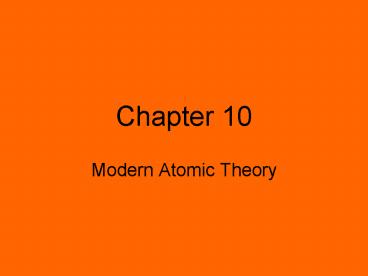Modern Atomic Theory - PowerPoint PPT Presentation
1 / 49
Title:
Modern Atomic Theory
Description:
Wave-Particle Duality of Nature. Electrons can behave as either waves or particles ... the electron as a particle. Schrodinger treated the electron as a wave ... – PowerPoint PPT presentation
Number of Views:820
Avg rating:3.0/5.0
Title: Modern Atomic Theory
1
Chapter 10
- Modern Atomic Theory
2
10.2 Electromagnetic Radiation
- EMR energy that travels through space
- as waves
- Is sound an example of EMR?
- Wave 3 properties
- A. Wavelength (lambda) ?
- B. Frequency (nu) ?
- C. Speed
3
Waves
- Wavelength measure peak to peak
- Frequency number of peaks that pass a point in
a given period of time - Speed how fast a wave moves through water
- See Figure 10.4 on page 282
4
Light
- Page 282 light as a wave and light as photons
- Photons- packets of energy
- Figure 10.6 Long waves lower energy
- Shorter waves higher energy
5
Emission of Energy by Atoms
- Excited atom has gained energy and is unstable
- Atoms seek stability lowest energy state
possible - Atoms will emit energy to become more stable and
return to ground state - Pages 284-285
6
An Apparent Contradiction
- Wave-Particle Duality of Nature
- Electrons can behave as either waves or particles
7
Newtonian Quantum Mechanics
- Newtonian Mechanics (classical mechanics)
describes visible objects at ordinary velocities - Quantum Mechanics describes extremely small
particles traveling near the velocity of light
8
Heisenburg Uncertainty Principle
- Werner Heisenberg German physicist
- It is impossible to know the exact position and
velocity of a moving object at the same time.
9
Schrodingers Work
- Erwin Schrodinger Austrian Physicist
- Heisenberg treated the electron as a particle
- Schrodinger treated the electron as a wave
10
Max Born
- Born used Schrodingers Equation to calculate the
probability of finding an electron - Led to the concept of the electron cloud
- Electron cloud has a vague and uncertain volume
11
4 Quantum Numbers
- Schrodingers equation uses 4 quantum numbers to
describe an electron - Principal Quantum Number (N)
- Tells distance from the nucleus
- Tells the amount of energy
- Maximum No. of electrons in an energy level is 2
N squared
12
Electron Arrangement Chart
13
Electron Arrangement Chart
14
Electron Arrangement Chart
15
2nd Quantum No.
- L, refers to the sublevel within an energy level
- The principal quantum no. tells you the number of
sublevels per level, they have the same value
16
Electron Arrangement Chart
17
Electron Arrangement Chart
18
Orbitals
- An orbital is the space shared by a pair of
electrons - An orbital can hold a maximum of 2 electrons. It
may contain less. - Sublevels are made up of orbitals
19
Electron Arrangement Chart
20
Electron Arrangement Chart
21
Electron Arrangement Chart
22
Electron Arrangement Chart
23
Electron Arrangement Chart
24
Electron Arrangement Chart
25
3rd Quantum No.
- Third Quantum No., m, defines each orbital
precisely by indicating its orientation in space.
26
Degenerate
- Orbitals in the same energy sublevel have the
same energy content. - The 3 3p orbitals have the same eneregy and are
said to be degerate
27
Electron Arrangement Chart
28
Electron Arrangement Chart
29
Electron Arrangement Chart
30
Electron Arrangement Chart
31
Electron Arrangement Chart
32
Electron Arrangement Chart
33
Electron Arrangement Chart
34
Electron Arrangement Chart
35
Electron Arrangement Chart
36
Electron Arrangement Chart
37
Electron Arrangement Chart
38
Electron Arrangement Chart
39
Electron Arrangement Chart
40
Electron Arrangement Chart
41
Electron Arrangement Chart
42
Electron Arrangement Chart
43
Electron Arrangement Chart
44
Pauli Exclusion Principle
- No 2 electrons can have the same set of 4 quantum
numbers.
45
The 4 Quantum Numbers
- 1.) The principal quantum no. (N) is the energy
level number. It gives information about the
side and energy of the level.
46
The 4 Quantum Numbers
- 2.) The second quantum number, l, is the energy
sublevel number. It gives information about the
shape of the electron cloud.
47
The 4 Quantum Numbers
- 3.) The third quantum number, m, is the orbital
quantum number. It gives information about the
orientation in space of the orbital.
48
The 4 Quantum Numbers
- 4.) The fourth quantum number, s, is the spin
quantum number. Electrons sharing an orbital
must have opposite spins. One spins clockwise
and the other counter-clockwise.
49
Distributing Electrons
- Electron Configuration Notation
- Orbital Notation
- Electron Dot Notation































